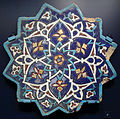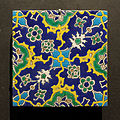Cuerda seca

Cuerda seca (Spanish for "dry cord") is a technique used when applying coloured glazes to ceramic surfaces.
Description
When different coloured glazes are applied to a ceramic surface, the glazes have a tendency to run together during the firing process. In the cuerda seca technique, the water-soluble glazes are separated on the surface by thin lines of a greasy substance to prevent them running out of their delineated areas. A dark pigment such as manganese carbonate is usually mixed with the grease to produce a dark line around each coloured area.[1]
History
Although some scholars have postulated an Iranian origin (citing Ummayyad-era examples from Suza),[2] many scholars believe that the cuerda seca technique originated primarily in al-Andalus (Islamic Spain and Portugal) in the second half of the 10th century, during the Umayyad period.[3][4][5] The technique was further advanced during the Taifas period in the 11th century.[3] Preserved fragments of tiles from the late 12th-century minaret of the Kasbah Mosque in Marrakesh, Morocco, have been cited as the earliest surviving example of cuerda seca tilework being used for architectural decoration.[5]
In central Asia tiles were manufactured using the cuerda seca technique from the second half of the 14th century.[6] The introduction of different coloured glazes is recorded in the mausoleums of the Shah-i-Zinda necropolis in Samarkand. In the 1360s the colours were restricted to white, turquoise and cobalt blue but by 1386 the palette had been expanded to include yellow, light-green and unglazed red.[7] Large quantities of cuerda seca tiles were produced during the Timurid (1370–1507) and Safavid (1501–1736) periods.[8]
In the 15th century Persian potters from Tabriz introduced the technique into Turkey and were responsible for decorating the Yeşil Mosque in Bursa (1419-1424).[9] Within the Ottoman Empire cuerda seca tilework fell out of fashion in the 1550s and new imperial buildings were decorated with underglaze-painted tiles from İznik. The last building in Istanbul to include cuerda seca tilework was the Kara Ahmed Pasha Mosque which was designed in 1555 but only completed in 1572.[10][11]
Gallery
-
Cuerda seca tile from the Alcazar of Seville, 12th-13th century
-
Tiles in the Green Mosque, Bursa, c. 1420
-
Details of the Green Tomb in Bursa
-
Tile from Khargird in Iran, mid 15th century
-
Ottoman tile, Istanbul, first half 16th century
-
Dish from Seville in Spain, early 16th century
Notes
- ^ Campbell 2006.
- ^ Soustiel, Jean (1985). La céramique islamique : le guide du connaisseur. Fribourg: Office du livre. ISBN 271910213X.
- ^ a b Pérez-Arantegui, Josefina; Soto, Mercedes; Castillo, Juan Ramon (1999). "Examination of the cuerda seca decoration technique on Islamic ceramics from al-Andalus (Spain)". Journal of Archaeological Science. 26 (8): 935–941. doi:10.1006/jasc.1999.0400.
- ^ Chapoulie, R.; Delery, C.; Daniel, F.; Vendrell-Saz, M. (2005). "Cuerda seca ceramics from al-Andalus, Islamic Spain and Portugal (10th−12th centuries AD): investigation with SEM–EDX and cathodoluminescence". Archaeometry. 47 (3): 519–534. doi:10.1111/j.1475-4754.2005.00217.x.
- ^ a b Lintz, Yannick; Déléry, Claire; Tuil Leonetti, Bulle (2014). Le Maroc médiéval: Un empire de l'Afrique à l'Espagne. Paris: Louvre éditions. p. 332. ISBN 9782350314907.
- ^ Porter 1995, p. 18.
- ^ Atasoy & Raby 1989, p. 373, fn 23.
- ^ Porter 1995, p. 20.
- ^ Atasoy & Raby 1989, p. 83.
- ^ Atasoy & Raby 1989, p. 220.
- ^ Necipoğlu 2005, pp. 377–384.
Sources
- Atasoy, Nurhan; Raby, Julian (1989). Iznik: The Pottery of Ottoman Turkey. London: Alexandra Press. ISBN 978-1-85669-054-6.
- Campbell, Gordon, ed. (2006). "Cuerda seca and cuenca tiles". The Grove Encyclopedia of Decorative Arts, Volume 1. New York: Oxford University Press. p. 293. ISBN 978-0-19-518948-3.
- Necipoğlu, Gülru (2005). The Age of Sinan: Architectural Culture in the Ottoman Empire. London: Reaktion Books. ISBN 978-1-86189-253-9.
- Porter, Venetia (1995). Islamic Tiles. London: British Museum Press. ISBN 978-0-7141-1456-9.
Further reading
- Gestoso y Pérez, José (1899). Ensayo de un diccionario de los artífices que florecieron en Sevilla : desde el siglo XIII al XVIII inclusive. Volume 1 (in Spanish). Seville: En la oficina de la Andalucía moderna. p. 77. OCLC 9986104.
External links
- The cuerda seca method, Qantara project.







